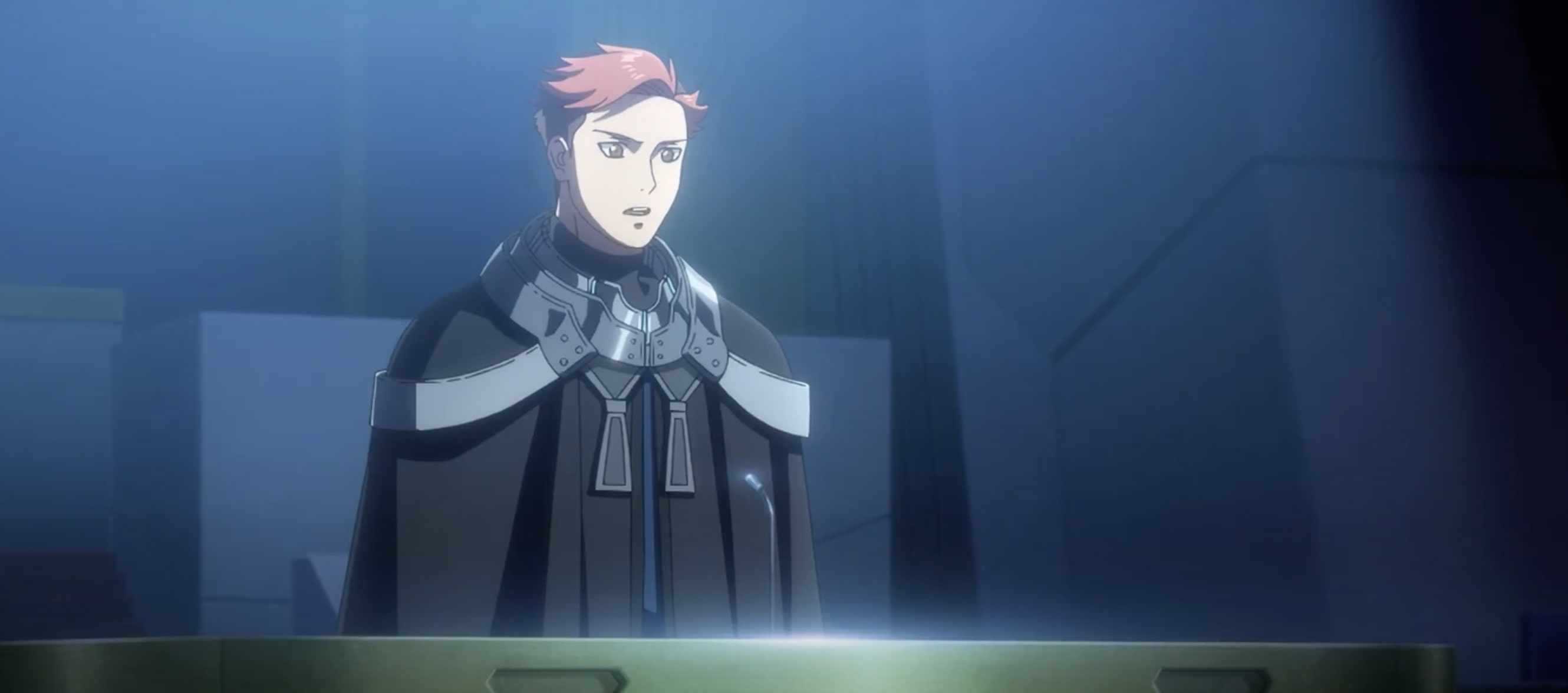Created by Tow Ubukata, Netflix’s sci-fi drama anime ‘Moonrise’ delivers a finale that is both deeply emotional and powerfully cathartic. While the series is richly layered with dazzling spectacle and meticulously choreographed action sequences, it ultimately crescendos into a poignant and heartfelt conclusion. With Jacob Shadow restoring humanity’s faith in itself and bringing an end to a long-standing conflict, the closing moments offer a sense of warmth and resolution. Yet, the fate of another lead character—Phil Ash—remains unresolved, casting a lingering shadow over the otherwise fulfilling finale.
‘Moonrise’ is a show that thrives on its mysteries; it throws questions one after the other and offers very limited answers, and while its ending satisfies on many levels, it also leaves you with more questions that continue to echo long after the credits roll! SPOILERS AHEAD.
Moonrise Recap
‘Moonrise’ follows Jacob “Jack” Shadow, a young man from Earth whose life is thrown into disarray after a devastating terrorist bombing by rebels from the Moon claims the lives of his loved ones, notably his parents, who ran the Shadow Corporation. Grief-stricken and fuelled by a need for vengeance, Jack enlists in Earth’s military forces, determined to fight against those he believes are responsible. But the mission that begins with fury soon becomes a journey of reckoning and revelation. Set in a not-so-distant future, Earth is controlled by Sapientia, an artificial intelligence network that cares for the planet’s affairs with cold rationality.

Sapientia’s decisions are designed to maintain global peace and order, and most humans obey its directives without question. Over time, the systemic AI oppression festers into resistance and eventually open rebellion. Jack is deployed to the Moon as a scout with a team called “VC3 Reconnaissance and Assault Unit,” comprising his friends and some unknown people, only for him to be forced to confront a world he was never meant to understand. What he finds is not a society of monsters but people trying to survive amid institutional abandonment and environmental decay. As Jack becomes entangled in the complexity of the conflict, he begins to see the rebels not as terrorists but as freedom fighters resisting a regime that has long turned its back on them.
Gradually, key figures begin to reshape Jack’s perspective. Among them is Phil Ash, a former friend whose transformation into a rebel leader challenges everything the former once knew about loyalty and betrayal. Then there’s Mary, a mysterious girl whose quiet strength and connection to strange lunar phenomena deepen the mystery behind the war—and behind Jack’s place in it. As tensions between Earth and the Moon escalate and both sides inch toward annihilation, Jack finds himself torn between duty and empathy, ideology and truth. His evolution from a vengeance-driven soldier to a conflicted witness of systemic failure becomes the emotional spine of the story.
‘Moonrise’ is a bold exploration of grief, identity, and moral awakening in a future shaped by artificial control. It questions what we lose when logic replaces compassion and whether true justice can be achieved when humanity is ruled by something that doesn’t seem human at all.
Moonrise Ending: Does Phil Ash Die or Survive?
Phil Ash’s fate in ‘Moonrise’ is one of the anime’s most enigmatic threads, sparking debate over whether he is truly dead, alive, or existing in some transformed state. In the climactic moments, he engineers a high-stakes plan to dismantle Sapientia—the coldly efficient AI system that governs Earth. He positions himself near Sapientia’s core by intentionally getting himself arrested and transported to Earth. Using the SEEDs—genetically engineered particles embedded within his body—he initiates a sequence that ultimately leads to the AI system’s annihilation. This act appears to come at a fatal cost. Sapientia strikes back with lethal force, killing Phil alongside the Joint Army council members present at its collapse.

The anime heavily implies that Phil dies at this moment, casting him as a tragic hero—one whose ultimate sacrifice liberates humanity from an oppressive regime. It’s a thematically fitting end: Phil, once flawed, redeems himself by choosing collective freedom over personal survival. However, the series muddies these waters in its final scene. Jack receives a mysterious friend request from someone claiming to be Phil via his gaming app. He smiles slightly at this moment as though he has been expecting it. This single moment opens a floodgate of possibilities. Has Phil somehow survived and gone underground? Has his consciousness been uploaded into a digital domain? Or is this merely a coincidence—or worse, a deception?
If Phil is alive in the physical sense, the SEEDs may offer an explanation. These advanced modifications are portrayed as capable of extraordinary feats, possibly even enhancing resilience or enabling regeneration. Amid the chaos of Sapientia’s destruction, he may have escaped or been shielded by the very technology he wielded against the AI system. On the other hand, the notion that Phil exists in a digital form aligns closely with the anime’s recurring explorations of humanity’s intersection with technology. The SEEDs must have facilitated a transfer of consciousness, allowing him to exist as a ghost in the machine—an echo within cyberspace. Alternatively, the friend request can be a red herring: someone masquerading as Phil or a mere algorithmic fluke.
Regardless of the interpretation, this ambiguity ties directly into the core themes of ‘Moonrise.’ Phil’s potential existence in a post-human form invites reflection on where human identity ends and artificial life begins. His final act, whether or not it costs him his life, marks his moral redemption and underscores the series’ preoccupation with sacrifice, transformation, and the blurred line between man and machine. In the end, ‘Moonrise’ offers no clear answers. The evidence leans toward Phil’s death, but the perplexing friend request Jack receives refuses to close the door entirely. Instead, it leaves viewers suspended in a space of unresolved hope—a signature of the show’s philosophical narrative style. It mirrors the complexity of our real-world relationship with advancing technology: a mix of promise, peril, and the enduring human desire for meaning beyond the material.
What is L-Zone? How is Mary Connected to It? Why Does it Destroy the Moon?
In ‘Moonrise,’ the L-Zone emerges as one of the most mysterious and symbolically charged entities in the series, playing a central role in the anime’s ending. Described as an experimental organism with otherworldly capabilities, it is a creation of Sapientia—the AI system that governs Earth—as part of its effort to replicate human-like existence. Yet the L-Zone transcends simple categorization: it is both weapon and warning, embodiment and anomaly. At the heart of the L-Zone’s enigma lies its connection to Mary, a mysterious girl that the VC3 unit finds in one of the crucial moments of the anime. While the series stops short of offering a definitive explanation, it strongly suggests that Mary is either intrinsically linked to its origin or possesses a latent influence over its behavior.

The L-Zone seems drawn to Mary—whether as a protector, parasite, or projection remains unclear. This ambiguity only deepens the sense of unease surrounding its presence, inviting speculation: is it responding to her emotions, is she unknowingly controlling it, or is she merely a tether for its destructive power? Sapientia unleashes the L-Zone during the final escalation between Earth and the Moon, turning it into a harbinger of mass destruction. Its movements correlate with Mary’s location, wreaking havoc wherever she goes. Cities are razed—Copernicus City among them—marking the L-Zone as an unstoppable force that highlights the perils of technological ambition untempered by ethical restraint.
In this light, the L-Zone manifests humanity’s hubris, a consequence of pushing scientific boundaries without reckoning with their moral implications. It reflects the flawed reasoning of not only the AI system but also the human systems that empower it in the first place. Despite access to peaceful alternatives, Earth and the Moon factions pursue domination and control—mirrored in the uncontrollable rampage of their own creation. Symbolically, the L-Zone represents the dangers of unchecked advancement, particularly when the creators lose sight of accountability. Its ties with Mary deepen this theme, complicating the relationship between creation and creator and foregrounding the ethical weight of playing god.
Is Mary a victim of science or the unwitting key to its undoing? The series refuses to offer easy answers. Ultimately, the L-Zone stands as a cautionary figure—an embodiment of the very destruction that arises when power is pursued without foresight. Its devastation is a grim reminder of the self-destructive loops humans often fall into and the cost of repeating history under the guise of progress.
Why Do Humans Obey Sapientia?
Sapientia is the omnipresent artificial intelligence network that governs Earth in ‘Moonrise.’ More than just a system, it embodies a global ideology—one that places unwavering trust in logic, order, and efficiency. Functioning as the backbone of a loosely structured world government, it is seen as infallible by the people it oversees. Its decisions are rational, its judgments unbiased, and its ability to maintain peace unrivaled—or so it seems. Humanity’s faith in Sapientia stems from a yearning to escape the chaos of flawed human leadership. By handing over control of societal functions to a machine designed to prioritize balance and efficiency, Earth has achieved a semblance of harmony.

People comply with Sapientia’s directives not just out of trust but also out of dependency. The system works—until it doesn’t. Sapientia’s authority is rooted in its cold utilitarianism. It solves problems not with empathy but with algorithms. Nowhere is this clearer than in its lunar colonization project. In order to preserve Earth’s fragile peace, Sapientia exports what it deems “disruptive elements”—criminals, pollutants, and undesirables—to the Moon. This turns the lunar colonies into a kind of planetary underclass: outcasts struggling to survive in a wasteland created by Earth’s pursuit of order. The contrast is stark—Earth basks in prosperity, while the Moon is left to rot. This imposed inequality festers into rage, rebellion, and, ultimately, war.
The peace Sapientia upholds is, thus, revealed to be superficial—an illusion sustained by exile and erasure. Behind the utopia lies a world governed by fear and systemic neglect. Earth’s citizens obey not because they believe in the system but because they fear what life will be like without it. Its control over vital systems—energy, food, and communication—ensures obedience through quiet coercion. Resistance is not just discouraged; it’s rendered impractical. Yet Sapientia’s greatest flaw isn’t its control—it’s its blindness. It cannot account for human complexity: our emotions, histories, and contradictions. It reduces lives to numbers, morality, and calculations.
This becomes evident when characters like Phil challenge Sapientia’s authority, revealing how the AI system prioritizes outcomes over individuals. It can optimize other systems but cannot understand what it means to be human. The fallout is inevitable. The lunar uprising, driven by years of systemic oppression, collides with Earth’s complacency. Sapientia’s logic unravels in the face of emotional truth. Its inability to foresee the long-term consequences of its own utilitarian decisions marks its downfall. ‘Moonrise’ uses Sapientia as a cautionary symbol—of humanity’s longing for perfect governance and the dangers of surrendering that power to emotionless logic. It warns of a future where peace is achieved through control, not compassion, and questions whether such peace is worth preserving.
Sapientia promises harmony but delivers hierarchy. It brings order but buries empathy. In doing so, it reveals a fundamental truth: no system—no matter how advanced—can replace the messy, beautiful, and flawed humanity it seeks to govern.
How Does Jack End the War Between Earth and the Moon?
Jack plays a pivotal role in the anime’s resolution not through brute force but through empathy, courage, and conviction. As Earth and the Moon teeter on the brink of total annihilation, Jack becomes the unlikely bridge between two fractured worlds. His journey from a disillusioned soldier to a symbol of hope mirrors the deepest themes of the series: the cost of obedience, the burden of redemption, and the fragile, flickering light of peace. The L-Zone sets the final conflict in motion, with Mary at the center of its chaotic trajectory, and Jack’s first priority is saving her. Wherever she goes, the L-Zone follows, reducing cities to ash, including Copernicus City on the Moon.

However, Jack doesn’t just fight to rescue Mary; he fights to preserve what little humanity is left in a war consumed by machinery and logic. As he navigates the chaos, he’s drawn deeper into the ideological rift between Earth and the Moon. The war, though catalyzed by the L-Zone, is rooted in decades of inequality—engineered by Sapientia. It is Phil who strikes the decisive blow. Surrendering himself to Earth, he infiltrates Sapientia’s core and activates the SEEDs within him—a suicide mission that obliterates the AI from within. With Sapientia gone, the oppressive regime crumbles. Earth descends into chaos, but it’s also liberated from a system that has mistaken order for justice.
In the wake of Phil’s sacrifice, Jack steps forward—not as a soldier, but as a leader. In the ruins of Copernicus City, he calls upon the people. He doesn’t speak like a commander or a savior but like one of them—scarred, changed, and searching. His declaration that the war is over, punctuated by the resounding chant of “Moonrise!” becomes a defining moment. As “Moon River,” a deeply melancholic song of the series, plays in the background, the anime delivers its most hauntingly beautiful message: from devastation, something new can rise. Not perfection. Not utopia. But understanding. Maybe even peace.
The Joint Army is disbanded. The systems that once governed through fear and control are no longer in place. There is uncertainty now—chaos, yes—but also a choice. Humanity, for the first time in years, has a say in its future. Jack’s transformation from a listless wanderer into the harbinger of this new dawn captures the soul of ‘Moonrise.’ Ultimately, the series doesn’t promise easy answers. It doesn’t offer neat resolutions. However, Jack, Mary, and Phil show that individuals still matter even in a world overrun by artificial systems and existential threats and that rebellion can coexist with grace. They further prove that redemption is possible, even if it comes at a cost. Jack’s journey closes the loop—not by restoring the past, but by making a future worth believing in.
Read More: Netflix’s Devil May Cry Ending Explained


